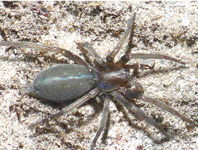Abstract
Almost 30% of female American sand flies are morphologically indistinguishable from one another. These females belong to species-complexes or groups with closely related species, making species-level identification difficult or even impossible. This fact has implications for public health since several of these groups include species which are vectors of human pathogens. Thus, new tools are needed to minimize species-level identification problems. In this context, our research sought to use geometric morphometry in the study of the head of females of closely related species of the genus Psychodopygus, Chagasi series, which includes the following species: P. chagasi, P. complexus, P. squamiventris maripaensis, P. squamiventris squamiventris, and P. wellcomei. We have used ten landmarks distributed on the head of these species. All species were clearly distinguished using the centroid size and shape together. These results highlight the head analysis as an effective tool for future geometric morphometry studies in sand flies.
References
Baracchi, D., Turillazzi, S. & Chittka, L. (2016) Facial patterns in a tropical social wasp correlate with colony membership. Die Naturwissenschaften, 103, 1–6.
https://doi.org/10.1007/s00114-016-1406-8Cerqueira, N.L. (1943) Um novo meio para montagem de pequenos insetos em lâmina. Memórias do Instituto Oswaldo Cruz, 39, 37–41.
https://doi.org/10.1590/S0074-02761943000400003De la Riva, J., Le Pont, F., Ali, V., Matias, A., Mollinedo, S. & Dujardin, J.P. (2001) Wing geometry as a tool for studying the Lutzomyia longipalpis (Diptera: Psychodidae) complex. Memórias do Instituto Oswaldo Cruz, 96, 1089–1094.
https://doi.org/10.1590/S0074-02762001000800011Dujardin, J.P., Le Pont, F. & Baylac, M. (2003) Geographical versus interspecific differentiation of sand flies (Diptera: Psychodidae): a landmark data analysis. Bulletin of entomological research, 93, 87–90.
https://doi.org/10.1079/BER2002206Forattini, O.P. (1973) Entomologia Médica. IV: Psychodidae. Phlebotominae. Leishmanioses. Bartonelose. Ed. Edgard Blücher Ltda., São Paulo, 658 pp.
Freitas, M.T., Ríos-Velasquez, C.M., Costa, C.R.L., Figueirêdo, C.A.S., Aragão, N.C., da Silva, L.G., de Aragão Batista, M.V., Balbino, T.C.L., Pessoa, F.A.C. & Balbino, Q.V. (2015) Phenotypic and genotypic variations among three allopatric populations of Lutzomyia umbratilis, main vector of Leishmania guyanensis. Parasites & Vectors, 8, 448.
https://doi.org/10.1186/s13071-015-1051-7Galati, E.A.B. (2018) Phlebotominae (Diptera, Psychodidae): Classification, Morphology and Terminology of Adults and Identification of American Taxa,. In: Rangel, E.F. & Shaw, J. (Eds.), Brazilian Sand Flies. Springer, Berlin, pp. 9–212.
https://doi.org/10.1007/978-3-319-75544-1_2Godoy, R.E., Galati, E.A.B., Cordeiro-Estrela, P., Souza, N.A., Santos, T.V., Sousa, L.C. & Rangel, E.F. (2014) Comparative study of the phlebotomine sand fly species (Diptera: Psychodidae: Phlebotominae) of the genera Nyssomyia Barretto, 1962, Bichromomyia Artemiev, 1991, and Migonemyia Galati, 1995, vectors of American cutaneous leishmaniasis in Brazil. Zootaxa, 3838, 501–517.
https://doi.org/10.11646/zootaxa.3838.5.1Godoy, R.E. (2018) Taxonomia integrativa de espécies, com fêmeas morfologicamente similares, do gênero Psychodopygus (Diptera, Psychodidae), Série Chagasi, registradas no Brasil. Faculdade de Saúde Pública, Universidade de São Paulo, São Paulo, 217 pp.
Gurgel-Gonçalves, R., Ferreira, J.B.C., Rosa, A.F., Bar, M.E. & Galvão, C. (2011) Geometric morphometrics and ecological niche modelling for delimitation of near-sibling triatomine species. Medical and Veterinary Entomology, 25, 84–93.
https://doi.org/10.1111/j.1365-2915.2010.00920.xHansen, T.F. & Houle, D. (2004) Evolvability, Stabilizing Selection, and the Problem of Stasis. In: Pigliucci, M. & Preston, K. (Eds.), Phenotypic Integration: Studying the Ecology and Evolution of Complex Phenotypes. Oxford University Press, New York, pp. 1–27.
Jaramillo, O.N., Castillo, D. & Wolff, E.M. (2002) Geometric morphometric differences between Panstrongylus geniculatus from field and laboratory. Memórias do Instituto Oswaldo Cruz, 97, 667–673.
https://doi.org/10.1590/S0074-02762002000500015Klingenberg, C.P. (2011) MorphoJ: an integrated software package for geometric morphometrics. Molecular Ecology Resources, 11, 353–357.
https://doi.org/10.1111/j.1755-0998.2010.02924.xNattero, J., Piccinali, R.V., Macedo Lopes, C., Hernández, M.L., Abrahan, L., Lobbia, P.A., Rodríguez, C.S. & Carbajal de la Fuente, A.L. (2017) Morphometric variability among the species of the Sordida subcomplex (Hemiptera: Reduviidae: Triatominae): evidence for differentiation across the distribution range of Triatoma sordida. Parasites & Vectors, 10, 412.
https://doi.org/10.1186/s13071-017-2350-yPizzo, A., Mazzone, F., Rolando, A. & Palestrini, C. (2011) Combination of geometric morphometric and genetic approaches applied to a debated taxonomical issue: the status of Onthophagus massai (Coleoptera, Scarabaeidae) as an endemic species vicarious to Onthophagus fracticornis in Sicily. Zoology, 114, 199–212.
https://doi.org/10.1016/j.zool.2011.03.003Prudhomme, J., Gunay, F., Rahola, N., Ouanaimi, F., Guernaoui, S., Boumezzough, A., Bañuls, A.-L., Sereno, D. & Alten, B. (2012) Wing size and shape variation of Phlebotomus papatasi (Diptera: Psychodidae) populations from the south and north slopes of the Atlas Mountains in Morocco. Journal of vector ecology, 37, 137–147.
https://doi.org/10.1111/j.1948-7134.2012.00210.xPugedo, H., Barata, R.A., França-Silva, J.C., Silva, J.C. & Dias, E.S. (2005) HP: an improved model of suction light trap for the capture of small insects. Revista da Sociedade Brasileira de Medicina Tropical, 38, 70–72.
https://doi.org/10.1590/S0037-86822005000100017Rangel, E.F. & Lainson, R. (2009) Proven and putative vectors of American cutaneous leishmaniasis in Brazil: aspects of their biology and vectorial competence. Memórias do Instituto Oswaldo Cruz, 104, 937–954.
https://doi.org/10.1590/S0074-02762009000700001Rohlf, F.J. & Marcus, L.F. (1993) A revolution morphometrics. Trends in Ecology & Evolution, 8, 129–132.
https://doi.org/10.1016/0169-5347(93)90024-JRohlf, F.J. (2010) tpsDig. Department of Ecology and Evolution, State University of New York, Stony Brook. [software]
Shannon, R.C. (1939) Methods for Collecting and Feeding Mosquitoes in Jungle Yellow Fever Studies. The American Journal of Tropical Medicine and Hygiene, s1-19, 131–140.
https://doi.org/10.4269/ajtmh.1939.s1-19.131Vilela, M.L., Zwetsch, A. & Silva, J.S. (2018) Methods for Capturing, Processing and Preserving Phlebotominae. In: Rangel, E. & Shaw, J. (Eds.), Brazilian Sand Flies. Springer, Cham, pp. 443–466.

